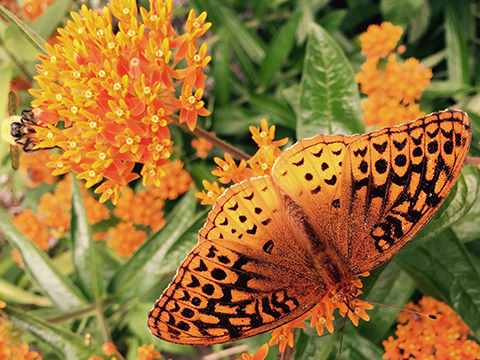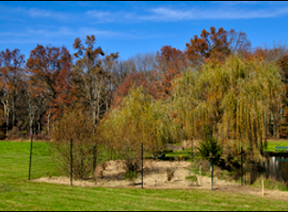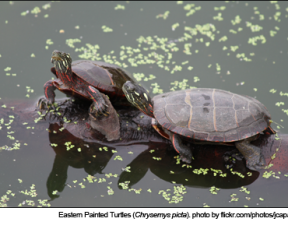By GSWA Volunteer, Jim Northrop
Human interaction with nature can be a mixed blessing. The plight of the beautiful monarch butterfly is a good example of unintended consequences when advances in technology are interjected into the natural world.
Why has the Monarch butterfly population recently decreased so dramatically? Over the past 20 years, the North American Monarch population has dropped from about one billion in the mid-1990’s, to less than 60 million today.
In order to understand how this has happened, we must first look at the life cycle of the Monarch butterfly.
Adult monarchs lay one small egg on an individual milkweed plant. Milkweed is the only “incubator” Monarchs will accept. The egg is about the size of the period at the end of this sentence. Progressing from egg to adult takes about one month, depending on the temperature. However, developing from egg to Monarch larvae (caterpillars) takes only about four days. The larvae consume a lot of milkweed for about two weeks, and grow very rapidly. Because they grow so fast, they need to shed their skin five times before the larvae transforms into the pupa or chrysalis stage. The chrysalis is similar to a hanging sack, with the larvae inside. Here the Monarch’s wings are developed and pumped up by using fluid stored in the Monarch’s abdomen. The caterpillar’s life inside the chrysalis lasts about ten days. Then, on to the Monarch’s wonderful life as an adult butterfly, which lasts only from about two to six weeks. After that short period of freedom and reproduction, the butterfly dies. Thus, the total time frame of one Monarch butterfly’s life cycle is only 6 to 10 weeks.
The monarch butterfly does not do well in cold weather, but beginning in March or April Monarchs become active, mate, and lay their eggs —- thus, they begin the first of four generations of butterflies (birth to death) which will be produced in a given year. That means four times each year Monarchs must find the milkweed upon which their larvae depend for food and development into adult Monarch butterflies.
Milkweed contains a variety of chemical compounds that make Monarch caterpillars poisonous to potential predators. Milkweeds contain a cardiac (heart) poison that is poisonous to most vertebrates (animals with backbones), but does not hurt the Monarch caterpillar.
However, dependence on available milkweed has become a problem for the Monarchs – part of the complex story of how modern technology has helped farmers and gardeners, but hurt the Monarchs.
In many areas of North America, especially in the Midwest, the scores of wild milkweed species among grasslands and farms are fast disappearing. Nearly 60% of native Midwestern milkweeds vanished between 1999 and 2009, according to the journal Insect Conservation and Diversity.
This loss coincides with increased applications of the weed killer Roundup (glyphosphate) on expanded plantings of corn and soybeans genetically altered to tolerate the herbicide. Meanwhile, Monarch reproduction in the Midwest dropped more than 80%.
With the loss of native milkweeds (which normally die each fall) Monarchs are encountering more and more “tropical” milkweeds that thrive year-round. Some concerned gardeners have planted “tropical” milkweed to help replace some of the Monarchs favored breeding habitat. “Tropical” milkweed is readily available as commercially grown milkweed sold by garden centers.
But, scientists suspect that when Monarchs encounter lush “tropical” milkweed foliage, while the native is fading in the fall, they may become confused and start breeding and laying their eggs in the “tropical” milkweed. Unfortunately, “tropical” milkweed is not the same resource they had been using. Here’s the problem: apparently, non-stop breeding on the same plants can unleash a devastating parasite called OE, for Ophryocystis elektroscirrha. Because “tropical” milkweed does not die off in the winter, but produces foliage year-round, there is no winter-time period when the parasites for which it is home, will be killed off. This is a problem for breeding Monarchs which are tempted to deposit their eggs in the “tropical” milkweed plants. The ease of substituting “tropical” for native milkweeds allows the breeding Monarchs to stay put, and not migrate for the winter to Mexico or Southern California, so they keep breeding all winter. And that’s how problems arise for Monarchs from disease.
Adult Monarchs infested with the parasite can carry millions of spores that contaminate milkweed and kill foraging caterpillars. Even mildly infected Monarchs often can’t fly or reproduce normally, and die early. Since 2002, the reported prevalence of OE among eastern migratory populations has increased nearly threefold.
Scientists do not dispute that the loss of milkweed habitat remains the Monarch’s biggest threat. But if the populations gets smaller, risks once considered less important – like severe weather, climate change, and disease —- could prove very threatening.
Milkweed plants that are treated with insecticides called neonicitinoids can kill caterpillars. Insecticides are systematic — meaning they affect every part of the milkweed plant. When caterpillars eat treated leaves, the caterpillars fall of the plant in minutes, curl up into a C shape and slowly die. So insecticides do not seem to be the antidote for “tropical” milkweed parasites. However, a better solution is for farmers and gardeners to not plant “tropical” milkweed in the first place, and where it is growing wild, to regularly cut it back to perhaps 6 inches off the ground, year-round.
The latest Monarch butterfly count (reported in January, 2015) found that the Monarch population in the U.S. improved from last year’s low. Monarch numbers increased to 56.5 million from 33.5 million, according to scientists. When one considers that in the mid 1990’s the Monarch population was about one billion, there is some improvement, but we have a long way to go!





